How the tech industry is redesigning the future workplace
- Published
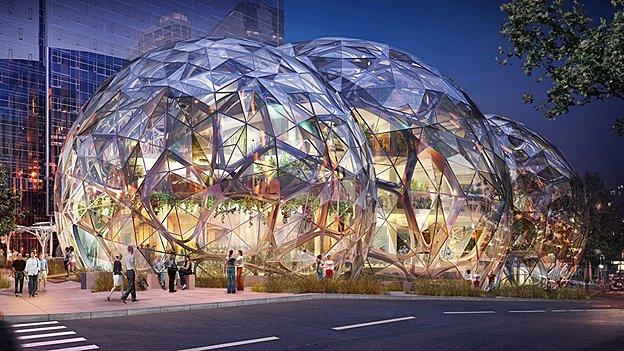
Brave new office space: This is Amazon's biosphere - is this the future workplace made of glass?
First, the technology sector gave us Google's bean bags and Facebook's feted ping-pong tables.
Now these companies are raising jousting skyscrapers into the Silicon Valley skyline.
Facebook has just this month moved into new headquarters designed by Frank Gehry, designer of Spain's Guggenheim Museum.
Its chief executive, Mark Zuckerberg, describes it as the largest open-floor plan in the world. Atop it lies a nine-acre rooftop park.
Google, Amazon, and Apple are also creating their own new colossal headquarters.
Google, searching for more space, will move shortly into its new "Googleplex".
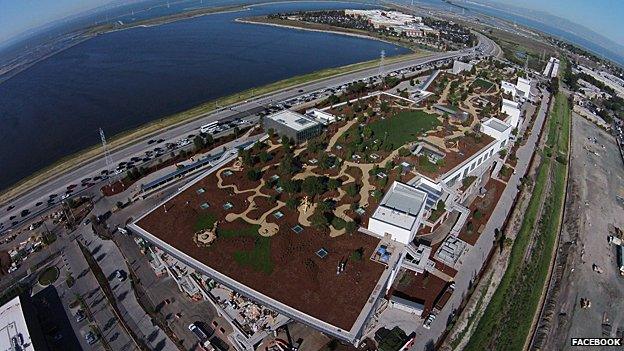
Facebook's new headquarters, designed by Frank Gehry
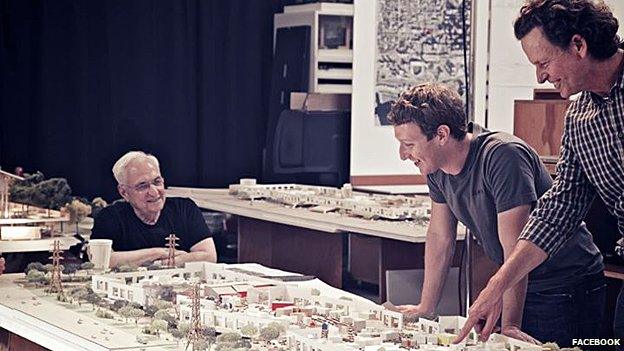
Facebook founder Mark Zuckerberg looks at a model of the new building with architect Frank Gehry
Apple's "spaceship", a vast watchstrap fashioned like a flying saucer, has already attracted the moniker of 'death star' from the unkind.
And Amazon's Seattle glass-dome biospheres, planned to open in 2016 and 2017, play none-too-subtly on its name.
Each is a stab at capturing an imaginative futuristic high ground - and employees - from competitors.
But they also hark back to vaunted tech structures like Bell Labs' buildings and MIT's Building 20, hastily erected in 1943, but flexible and forcing people working on very different projects to meet.
Tech has grown out of the garage.
The audacious scale of these spaces is a bid at bettering the odds of the serendipitous encounters - bumps in Silicon Valley vernacular - which helped Building 20's occupants share ideas across specialisms.
Shiny new workplaces are springing up from San Francisco to Shoreditch and Shenzhen.
It 's not just technology behemoths who have embraced this way of working. The BBC's new Broadcasting House, for example, encourages hot desking, with 460 workstations in its open-plan newsroom alone.
But this brave new world of work has critics.
For some, open plan spaces suggest managers on the room's sidelines, watching workers huddled in the middle like prey on the African savannah.
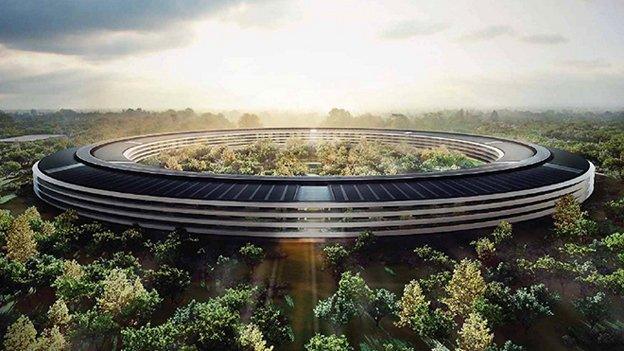
Apple's 'spaceship'
Flex desk
Seattle architecture firm NBBJ is behind the Google and Amazon buildings, as well as the new Guangdong headquarters for Chinese internet titan Tencent.
Offices are moving away from the idea that time at a desk is a measure of how productive you are, says Ryan Mullenix, an NBBJ design partner, and the chief designer of the new Google building.
And more broadly, away from ideals of industrial efficiency associated with early twentieth-century American mechanical engineer Franklin Taylor.
Sometimes a longer walk to get coffee may be better than a shorter one.
"It's who you see on the way to coffee, and movement which charges your brain, which is really valuable and part of work," says Mr Mullenix.
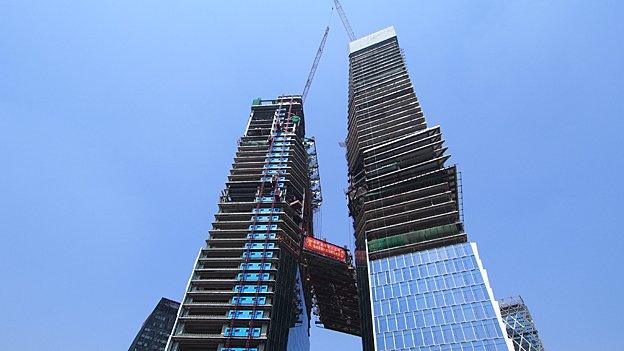
Tencent's new office buildings under construction in Guangdong, China
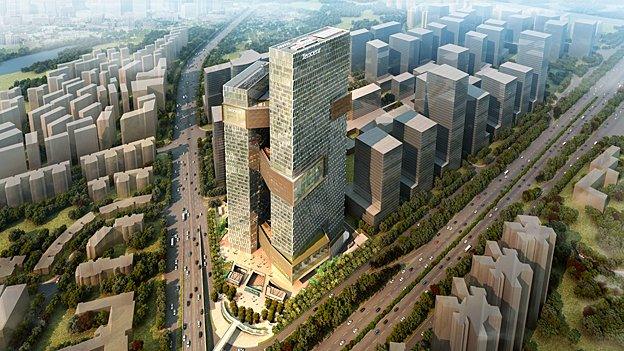
Here's how the architects see the finished Tencent building looking
The social side of work may soon be the only reason we have office buildings, says Scott Wyatt, NBBJ's chairman.
"Getting together with people in teams is where innovation happens, and makes us happy," he says. "You're not going to be happy holed up at home doing all your work."
"The company which gives the employees the choice at any given moment to optimise their effectiveness is going to win," says Mr Wyatt.
And a recent all-night hackathon, where ideas are developed, sponsored by NBBJ produced an app to let employees find available working spaces nearby, arranged by variables such as light, ambient noise, and the number of people around.
Crucial in all this is the new mobility which stems from more portable devices and cloud computing.
"If you sit at your desk for more than twenty minutes, you start getting stupider," says the chairman.
His architecture firm posts maps next to lift doors, suggesting outdoor walking routes for meetings of various lengths.
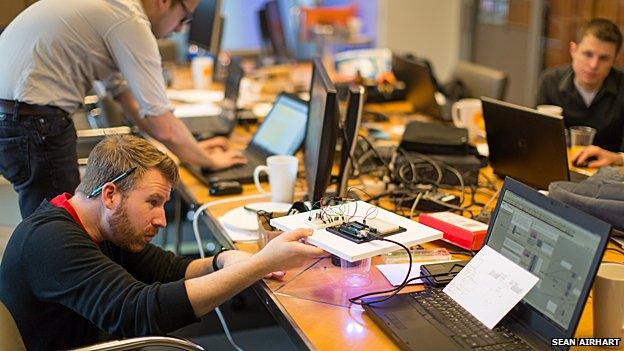
Building prototypes at the NBBJ hackathon
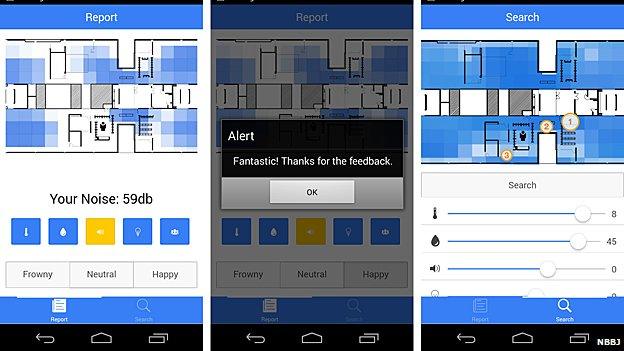
This app is designed to let workers find appropriate workspaces
Pixel while you work
Technology, media, and telecommunications firms set trends in the future design of the office, because they are the first sectors with members of Generation X - those born from the early sixties to the early eighties - in the boardroom, says architect Nicola Gillen.
She specialises in performance and the built environment at the firm AECOM.
She says many of the newest ideas about the office trace their origin to British architect Dr Frank Duffy CBE, who in the 1960s brought Northern European ideas of flexible office landscaping (or Bürolandschaft) into the English-speaking world.
Influenced by Scandinavian egalitarianism, these theories encouraged different levels of staff to work together in non-hierarchical environments in an open floor.
They appealed to many in postwar Europe. They also seem to appeal to the youngest graduates of today.

An architect's view of what the new Googleplex will look like
Millennials "are used to different ways of working, sharing, and collaborating, even from an early age," says Elaine Rossall, head of London market research for property consultants Cushman & Wakefield.
She thinks there has been a retreat from the last decade's enthusiasm for working from home, and points to growing so-called "worktivity" amenities, from running tracks to social, play, and eating areas, "to kind of keep people in the building".
The youngest workers also are digital natives, who come into the workplace expecting to have the latest type of tech, says Paul Phillips, head of consultancy services at the workplace consultancy Assurity Consulting, based in West Sussex.
He thinks wearable technology will soon lead to new ways of presenting information about a building to its users.
And increasingly globalised businesses and markets will spur new development in telepresence and teleconferencing, to cut costs and help the environment, he says.
Working like a dongle
With acute skill shortages in certain areas of the tech sector, to attract and retain young graduates it is increasingly important for employers to adapt to their habits, Mrs Rossall says.
And also to where they are.
Millennials have gravitated to grittier urban areas with lower housing costs, like East London.
This in turn opens up new areas of London to employers, who can draw their workforce from a different catchment.
Companies like Amazon, with its Seattle office, are moving away from suburban business parks, and back into cities.
"It's where their young and hip employees want to live, of course, but walkable urban campuses are also much more environmentally sustainable than suburban office parks," says Seattle-based Scott Bonjukian, who writes a blog called the Northwest Urbanist.
At the same time, he is worried this move will lead to rapidly rising rents, and lessen the very diversity of our neighbourhoods, places, and people which makes urban environments attractive.
Open and shut
Another challenge for designers of the future office is catering for workers from four generations, Millennials, Generations X and Y, and Baby Boomers in senior management.
Open-plan offices can be cheaper for companies to set up, by up to 20%, according to Dr Vinesh Oommen, at the Queensland University of Technology.
But despite the efforts of some architects, they can easily be done badly.
90% of studies found open-plan offices were associated with higher levels of stress and elevated blood pressure, Dr Oommen found.

Render of what Samsung's US headquarters in San Jose will look like
And older generations might particularly relish having a room of their own.
Mr Mullenix says whether the open office is good or bad is "probably the wrong question".
It is the ability to create different areas within a campus and building, catering for different working styles that is important, he says.
Architectural and design innovations quickly radiate from buildings like Google's to shape the office of the future.
And tellingly, the tech sector has made Office a byword for software as much as bricks-and-mortar hardware.
So don't be surprised if in the future you soon find yourself working in a wifi biosphere, a deathstar, or a bean-bag.